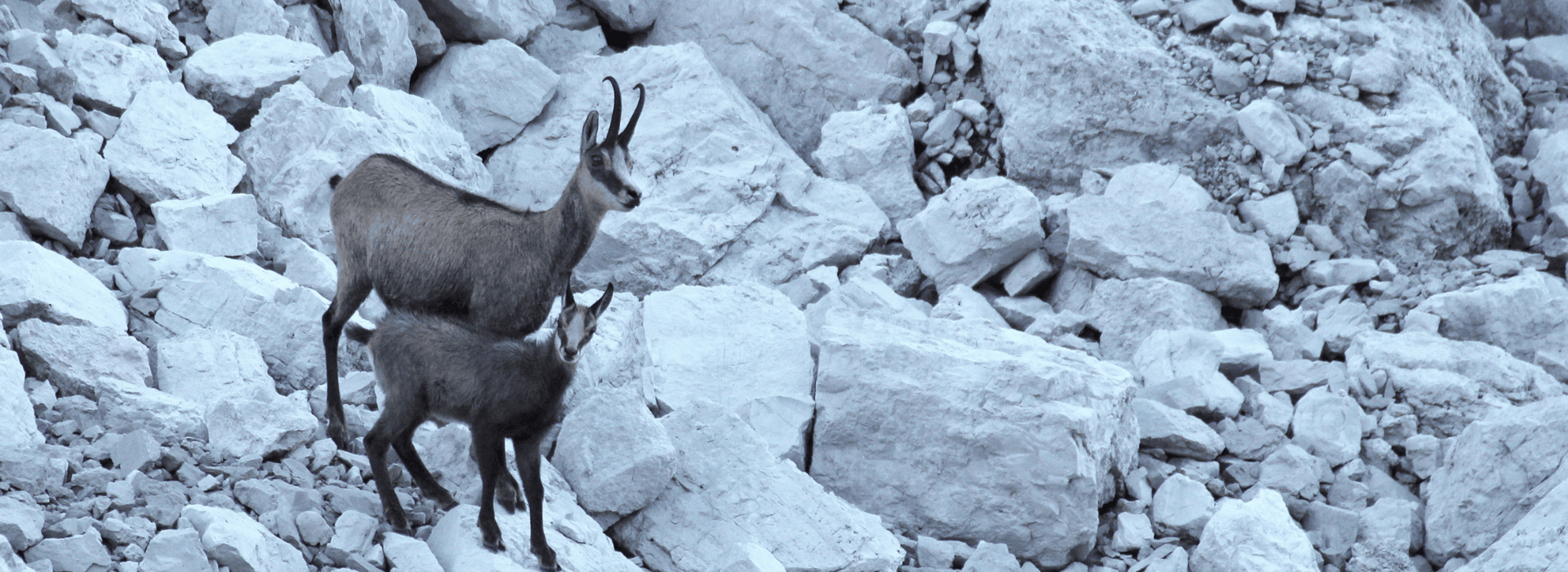
Groupe de travail Grands carnivores, ongulés sauvages et société - WISO
Les grands carnivores comme les loups, les ours et les lynx, ainsi que les ongulés sauvages comme les bouquetins, les chamois ou les cerfs rouges, sont des composantes importantes des écosystèmes alpins et sont fréquemment associés aux environnements alpins dans les représentations artistiques et culturelles.
Au cours des cinq dernières décennies, les populations de grands carnivores se sont considérablement reconstituées dans les Alpes, ce qui est largement reconnu comme une réussite en matière de conservation. Une approche concertée au niveau alpin est cruciale si nous voulons avoir une compréhension commune de la distribution et de la taille de leurs populations et mieux gérer les conflits avec les activités humaines telles que le pastoralisme, la sylviculture et la chasse.
Le principal objectif du groupe de travail Grands carnivores, ongulés sauvages et société (WISO), établi par la Xe Conférence alpine en 2009, est de trouver et de partager des solutions collaboratives pour gérer les grands carnivores et les ongulés sauvages en harmonie avec la société et sur la base d'une approche intégrée. Le groupe de travail va au-delà d'une approche strictement écologique et s'efforce de prendre en compte les aspects économiques et sociaux de manière équilibrée.
Au cours du mandat actuel, et dans la continuité des précédents, le groupe de travail WISO encourage le partage d'expériences entre les pays alpins afin d'évaluer la gestion des grands carnivores et des ongulés sauvages et leurs impacts sociaux et économiques. Les contextes européens et internationaux sur lesquels la législation nationale actuelle sur la gestion des grands carnivores et des ongulés sauvages est basée (la Convention de Berne et la Directive Habitats) sont également pris en compte.
Aperçu des activités, documents et résultats
- Mandate until the XIX Alpine Conference
- Activity Report 2023-2024
- Implementation of the management options for the conservation of the Brown bear in the Alps (2022)
- Summary on the wild ungulate management discussion (2022)
- Landscape connectivity for large carnivores and wild ungulates in the Alps (2022)
- Implementation of the management options for the conservation of the wolf in the Alps (2022)
- Activity Report 2021-2022
- Prevention of damages caused by large carnivores in the Alps (2020)
- Summary of the exchange on ungulate monitoring (2020)
- Activity Report 2019-2020
- Activity Report 2016-2019
- Preventing damage by large carnivores: A comparison of use of the European Agricultural Fund for Rural Development to protect livestock in the Alpine countries (2018)
- Guidelines for Common Management of Brown Bear in the Alpine and Northern Dinaric Region (2017)
- Statement on the DINALPBEAR report “Guidelines for Common Management of Brown Bear in the Alpine and Northern Dinaric Region”
- Wolf in the Alps: Recommendations for an internationally coordinated management (2016)
- Lynx in the Alps: Recommendations for an internationally coordinated management (2016)
- Defining, preventing and reacting to problem bear behaviour in Europe (2015)
- Report on the implementation of the RowAlps project (2014)
- Preliminary results of the EU pilot action on problem bear management in the Alpine bear population (2014)
- Preliminary version of the IBEX map in the Alps
- Cadre d’orientation de la Plate-forme « Grands carnivores » (adopté par la XIème Conférence alpine, à Brdo en 2011)
- Compréhension de la Plate-forme
- Première conférence de la Plate-forme « Grands Carnivores », 26-28 Avril 2012, Innsbruck
- Programme WISO Conference April 2012, Innsbruck
- WISO Platform Activities, Caroline Nienhuis
- Guidelines for Population Level Management, Urs Breitenmoser
- Brown bear management in Slovenia, Marko Jonozovic
- The genetic footprint of Alpine ibex reintroductions & implications for population management, Christine Grossen
- Results from the ECONNECT project, Ruedi Haller
- Monitoring standards for large carnivores in Germany, Felix Knauer
- Lynx Project Bayern, Sybille Wölfl
- Monitoring of wolves in the Alps, Francesca Marucco
- Working group Modeling
- Working group Monitoring
- Working group Human Dimensions
- Deuxième atelier de la Plate-forme « Grands carnivores » 1-3 Février 2010, Innsbruck
- Programme
- Information on the first meeting of the platform
- Situation of large carnivores in the Alps, Urs Breitenmoser
- Carnivores and Ungulates in the Alps, Ulrich Wotschikovsky
- Expectations of Alpine hunters towards governments concerning large carnivores and wild preys, Marco Giacometti
- Multifunctional close-to-nature forest management and wildlife management, Philippe Schütz
- Multifunctional Mountain Forestry, Kurt Ziegner
- Alpine outdoor sports–recent developments, nature compatibility & good practices for visitors guidance, Willi Seifert
- Viewpoints of the Alpenpark Karwendel, Tourism, Anton Heufelder
- Small Ruminants versus Large Carnivores in the Alps, Georg Höllbacher in Veronika Nowak
- Nature protection, Joanna Schoenenberger
- Platform "Ecological Network" of the Alpine Convention, Yann Kohler
- Alpine Space Project Econnect, Aurelia Ullrich
- Premier atelier de la Plate-forme « Grands carnivores » 22-23 Octobre 2009, Vaduz
- Information on the first meeting of the platform
- “Large carnivores and wild ungulates”,mandate, reasoning behind and working methods, Felix Näscher
- Platform “Large Carnivores and wild ungulates” and the Alpine Convention, Regula Imhof
- Living with large carnivores and wild ungulates in a changing ecological, economical and socio-cultural environment, Mario F. Broggi
- Guidelines "Large carnivores, wild ungulates and society" (adopted by the XI Alpine Conference, Brdo 2011)
- Background document - available in German, French, Italian and Slovenian
